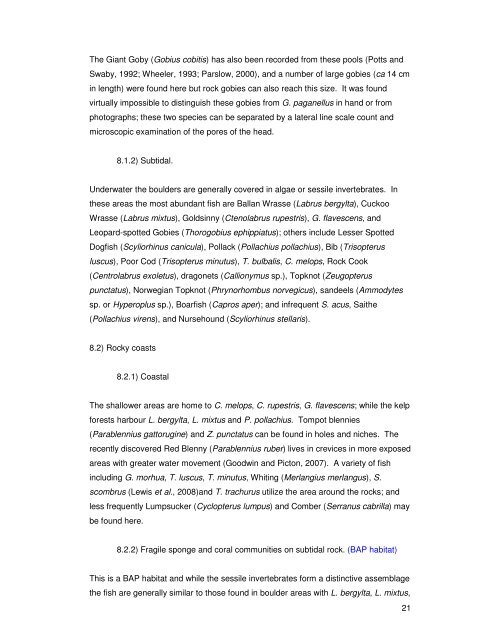Isles of Scilly Fish and Fisheries - Cornwall Wildlife Trust
Isles of Scilly Fish and Fisheries - Cornwall Wildlife Trust
Isles of Scilly Fish and Fisheries - Cornwall Wildlife Trust
You also want an ePaper? Increase the reach of your titles
YUMPU automatically turns print PDFs into web optimized ePapers that Google loves.
The Giant Goby (Gobius cobitis) has also been recorded from these pools (Potts <strong>and</strong><br />
Swaby, 1992; Wheeler, 1993; Parslow, 2000), <strong>and</strong> a number <strong>of</strong> large gobies (ca 14 cm<br />
in length) were found here but rock gobies can also reach this size. It was found<br />
virtually impossible to distinguish these gobies from G. paganellus in h<strong>and</strong> or from<br />
photographs; these two species can be separated by a lateral line scale count <strong>and</strong><br />
microscopic examination <strong>of</strong> the pores <strong>of</strong> the head.<br />
8.1.2) Subtidal.<br />
Underwater the boulders are generally covered in algae or sessile invertebrates. In<br />
these areas the most abundant fish are Ballan Wrasse (Labrus bergylta), Cuckoo<br />
Wrasse (Labrus mixtus), Goldsinny (Ctenolabrus rupestris), G. flavescens, <strong>and</strong><br />
Leopard-spotted Gobies (Thorogobius ephippiatus); others include Lesser Spotted<br />
Dogfish (Scyliorhinus canicula), Pollack (Pollachius pollachius), Bib (Trisopterus<br />
luscus), Poor Cod (Trisopterus minutus), T. bulbalis, C. melops, Rock Cook<br />
(Centrolabrus exoletus), dragonets (Callionymus sp.), Topknot (Zeugopterus<br />
punctatus), Norwegian Topknot (Phrynorhombus norvegicus), s<strong>and</strong>eels (Ammodytes<br />
sp. or Hyperoplus sp.), Boarfish (Capros aper); <strong>and</strong> infrequent S. acus, Saithe<br />
(Pollachius virens), <strong>and</strong> Nursehound (Scyliorhinus stellaris).<br />
8.2) Rocky coasts<br />
8.2.1) Coastal<br />
The shallower areas are home to C. melops, C. rupestris, G. flavescens; while the kelp<br />
forests harbour L. bergylta, L. mixtus <strong>and</strong> P. pollachius. Tompot blennies<br />
(Parablennius gattorugine) <strong>and</strong> Z. punctatus can be found in holes <strong>and</strong> niches. The<br />
recently discovered Red Blenny (Parablennius ruber) lives in crevices in more exposed<br />
areas with greater water movement (Goodwin <strong>and</strong> Picton, 2007). A variety <strong>of</strong> fish<br />
including G. morhua, T. luscus, T. minutus, Whiting (Merlangius merlangus), S.<br />
scombrus (Lewis et al., 2008)<strong>and</strong> T. trachurus utilize the area around the rocks; <strong>and</strong><br />
less frequently Lumpsucker (Cyclopterus lumpus) <strong>and</strong> Comber (Serranus cabrilla) may<br />
be found here.<br />
8.2.2) Fragile sponge <strong>and</strong> coral communities on subtidal rock. (BAP habitat)<br />
This is a BAP habitat <strong>and</strong> while the sessile invertebrates form a distinctive assemblage<br />
the fish are generally similar to those found in boulder areas with L. bergylta, L. mixtus,<br />
21

















